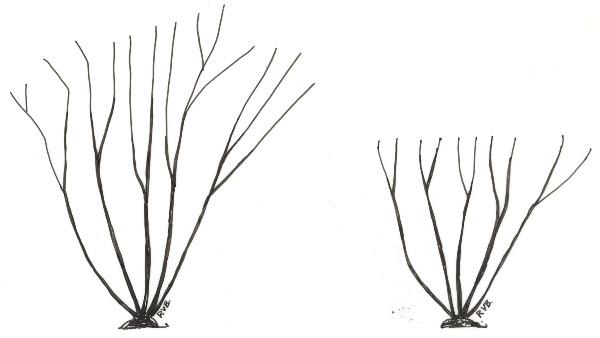Why prune roses?
Whether you are growing hybrid teas, climbers, or landscape roses, all roses require some pruning each year. Pruning is necessary to remove winter-killed canes (stems), control size, and train the plant for its best production of blossoms. However, different types of roses require different pruning techniques.
Except for climbers, pruning in the fall is needed to cut the tall canes to about thirty inches. This prevents the shrub from being loosened by the winter winds. In the spring, some roses are pruned a second time, but a bit more severely. With any rose, start the job conservatively by first removing dead or damaged branches. Then begin to selectively remove more of the canes according to what is needed by the type of rose. This controls growth and promotes healthy, vigorous new canes to produce blossoms.
Hybrid tea roses
Hybrid tea roses are the most popular rose, prized by hobbyists for their exquisite blossoms and fragrances. Hybrid tea roses purchased from nurseries usually have already been pruned to 12 to 18 inches at the time of sale, but they may require further cutting back to healthy tissue. After this initial trimming, pruning should be done each succeeding spring, but not as extreme as the first season’s cutting. Routine excessive pruning will adversely affect bloom production. Usually cutting to 15 to18 inches in the spring is sufficient.
Climbing and rambler roses
Climbing and rambler roses are the largest types of roses that always require some amount of annual pruning to keep them managed on a trellis or fence. Prune them according to their growth habit and the form desired. Start by removing the very old and declining canes of both types. Do not cut them back as much as you prune hybrid tea roses. Regular but moderate pruning of climbers will encourage a constant supply of younger, stronger blooming canes.
Landscape or ‘Knock-Out’ roses
Landscape roses such as the popular “Knock-out” variety are widely used in commercial settings, highway plantings, and home gardens. They are site hardy and resistant to black spot disease, the number one fungal disease affecting all roses. They bloom consistently through the summer until the fall killing frost. Their fragrant blossoms come in red, pink, and yellow. If not trimmed, landscape roses will grow to about 4 feet high and are useful as hedges or in mass landscape plantings.
Pruning landscape roses is very simple. Like other roses, they should be cut back before winter to around 30 inches high to reduce their loosening from the ground by winter winds. Then cut them back a little more in the spring. Start by first removing all broken or dead canes. To maintain size, cut them to about 20 inches. Soon afterwards they will sprout vigorous new canes that will produce many blossoms. Periodic light trimming of the canes may be needed to keep them within bounds throughout the summer. These roses are self-cleaning, meaning that after they bloom the old flowers drop off cleanly with no hips remaining, so routine cleaning is not needed like with other roses.
How to Make a Pruning Cut
Always use clean, sharp pruners. For small canes, a pair of “by-pass” style pruners works well. For larger canes use lopper pruners, and in some very old, woody roses a hand pruning saw may be needed. When cutting back a rose cane, make the cut at an angle or slant just above an outward pointing bud. Cutting the cane at a slant will permit water to run off the cut surface, reducing the chance for rot. Pruning to an outward bud encourages the branch to grow outwards, not into the center of the shrub. This creates a more desirable form with branches growing outward and the center of the shrub clear of tangled branches. Throughout the growing season you should also do some “dead-head” trimming, removing the spent blossoms and small, dead canes and branches.


